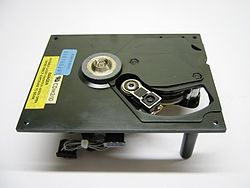Compact disc
A Compact Disc (CD) is a storage device in the form of small plastic compact discs which store and retrieve computer data or music using light. CDs replaced floppy disks and gramophone records because they were faster and could hold more information. The CD was invented by both Philips and Sony at the same time. Sony and Philips did work together to create a standard format and the technology to read a CD in 1982 (JP) and 1983 (outside JP). The CD can store up to 700 MB worth of data, which is about 74-80 minutes of music. The Mini CD has an 8 cm diameter with less music/data storage capacity than the CD of 12 cm. A CD and a Mini CD can have data or music storage capacity. The middle hole in a CD and Mini CD is about 1.5 cm.
Compact Disc Media
- Diagram of CD layers
- A polycarbonate disc layer has the data encoded by using bumps.*
- A shiny layer reflects the laser.*
- A layer of lacquer protects the shiny layer.*
- Artwork is screen printed on the top of the disc.*
- A laser beam is reflected off the CD to a sensor, which converts it into electronic data.*
Pits and lands of a compact disc under a microscope
The pits in a CD are 500 nm wide, between 830 nm and 3,000 nm long and 150 nm deep.
Sony CDP-101 from 1982, the first commercially released CD player for consumers
Related pages
| Wikimedia Commons has media related to Lua error in Module:Commons_link at line 62: attempt to index field 'wikibase' (a nil value).. |










